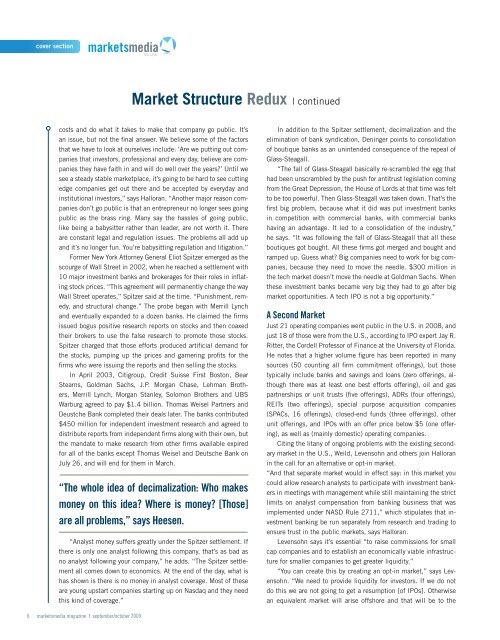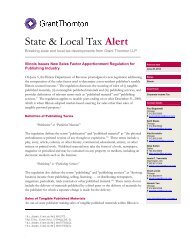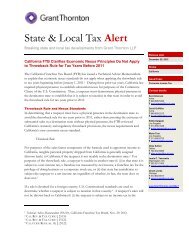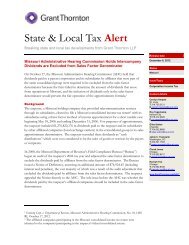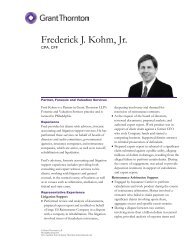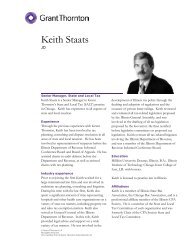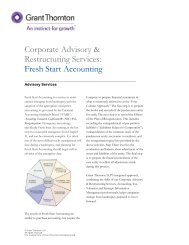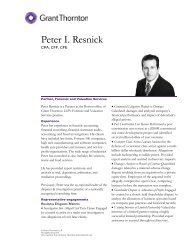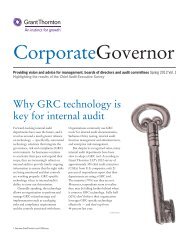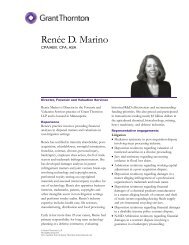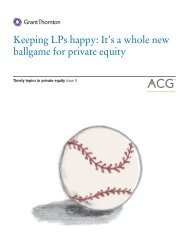Market Structure Redux - Grant Thornton LLP
Market Structure Redux - Grant Thornton LLP
Market Structure Redux - Grant Thornton LLP
You also want an ePaper? Increase the reach of your titles
YUMPU automatically turns print PDFs into web optimized ePapers that Google loves.
cover section<br />
<strong>Market</strong> <strong>Structure</strong> <strong>Redux</strong> I continued<br />
costs and do what it takes to make that company go public. It’s<br />
an issue, but not the final answer. We believe some of the factors<br />
that we have to look at ourselves include: ‘Are we putting out companies<br />
that investors, professional and every day, believe are companies<br />
they have faith in and will do well over the years?’ Until we<br />
see a steady stable marketplace, it’s going to be hard to see cutting<br />
edge companies get out there and be accepted by everyday and<br />
institutional investors,” says Halloran. “Another major reason companies<br />
don’t go public is that an entrepreneur no longer sees going<br />
public as the brass ring. Many say the hassles of going public,<br />
like being a babysitter rather than leader, are not worth it. There<br />
are constant legal and regulation issues. The problems all add up<br />
and it’s no longer fun. You’re babysitting regulation and litigation.”<br />
Former New York Attorney General Eliot Spitzer emerged as the<br />
scourge of Wall Street in 2002, when he reached a settlement with<br />
10 major investment banks and brokerages for their roles in inflating<br />
stock prices. “This agreement will permanently change the way<br />
Wall Street operates,” Spitzer said at the time. “Punishment, remedy,<br />
and structural change.” The probe began with Merrill Lynch<br />
and eventually expanded to a dozen banks. He claimed the firms<br />
issued bogus positive research reports on stocks and then coaxed<br />
their brokers to use the false research to promote those stocks.<br />
Spitzer charged that those efforts produced artificial demand for<br />
the stocks, pumping up the prices and garnering profits for the<br />
firms who were issuing the reports and then selling the stocks.<br />
In April 2003, Citigroup, Credit Suisse First Boston, Bear<br />
Stearns, Goldman Sachs, J.P. Morgan Chase, Lehman Brothers,<br />
Merrill Lynch, Morgan Stanley, Solomon Brothers and UBS<br />
Warburg agreed to pay $1.4 billion. Thomas Weisel Partners and<br />
Deustche Bank completed their deals later. The banks contributed<br />
$450 million for independent investment research and agreed to<br />
distribute reports from independent firms along with their own, but<br />
the mandate to make research from other firms available expired<br />
for all of the banks except Thomas Weisel and Deutsche Bank on<br />
July 26, and will end for them in March.<br />
“The whole idea of decimalization: Who makes<br />
money on this idea? Where is money? [Those]<br />
are all problems,” says Heesen.<br />
“Analyst money suffers greatly under the Spitzer settlement. If<br />
there is only one analyst following this company, that’s as bad as<br />
no analyst following your company,” he adds. “The Spitzer settlement<br />
all comes down to economics. At the end of the day, what is<br />
has shown is there is no money in analyst coverage. Most of these<br />
are young upstart companies starting up on Nasdaq and they need<br />
this kind of coverage.”<br />
In addition to the Spitzer settlement, decimalization and the<br />
elimination of bank syndication, Deninger points to consolidation<br />
of boutique banks as an unintended consequence of the repeal of<br />
Glass-Steagall.<br />
“The fall of Glass-Steagall basically re-scrambled the egg that<br />
had been unscrambled by the push for antitrust legislation coming<br />
from the Great Depression, the House of Lords at that time was felt<br />
to be too powerful. Then Glass-Steagall was taken down. That’s the<br />
first big problem, because what it did was put investment banks<br />
in competition with commercial banks, with commercial banks<br />
having an advantage. It led to a consolidation of the industry,”<br />
he says. “It was following the fall of Glass-Steagall that all these<br />
boutiques got bought. All these firms got merged and bought and<br />
ramped up. Guess what? Big companies need to work for big companies,<br />
because they need to move the needle. $300 million in<br />
the tech market doesn’t move the needle at Goldman Sachs. When<br />
these investment banks became very big they had to go after big<br />
market opportunities. A tech IPO is not a big opportunity.”<br />
A Second <strong>Market</strong><br />
Just 21 operating companies went public in the U.S. in 2008, and<br />
just 18 of those were from the U.S., according to IPO expert Jay R.<br />
Ritter, the Cordell Professor of Finance at the University of Florida.<br />
He notes that a higher volume figure has been reported in many<br />
sources (50 counting all firm commitment offerings), but those<br />
typically include banks and savings and loans (zero offerings, although<br />
there was at least one best efforts offering), oil and gas<br />
partnerships or unit trusts (five offerings), ADRs (four offerings),<br />
REITs (two offerings), special purpose acquisition companies<br />
(SPACs, 16 offerings), closed-end funds (three offerings), other<br />
unit offerings, and IPOs with an offer price below $5 (one offering),<br />
as well as (mainly domestic) operating companies.<br />
Citing the litany of ongoing problems with the existing secondary<br />
market in the U.S., Weild, Levensohn and others join Halloran<br />
in the call for an alternative or opt-in market.<br />
“And that separate market would in effect say: in this market you<br />
could allow research analysts to participate with investment bankers<br />
in meetings with management while still maintaining the strict<br />
limits on analyst compensation from banking business that was<br />
implemented under NASD Rule 2711,” which stipulates that investment<br />
banking be run separately from research and trading to<br />
ensure trust in the public markets, says Halloran.<br />
Levensohn says it’s essential “to raise commissions for small<br />
cap companies and to establish an economically viable infrastructure<br />
for smaller companies to get greater liquidity.”<br />
“You can create this by creating an opt-in market,” says Levensohn.<br />
“We need to provide liquidity for investors. If we do not<br />
do this we are not going to get a resumption [of IPOs]. Otherwise<br />
an equivalent market will arise offshore and that will be to the<br />
6<br />
marketsmedia magazine I september/october 2009


